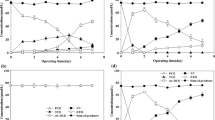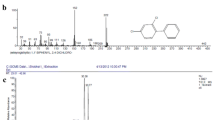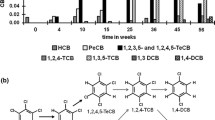Abstract
A consortium comprised of an engineered Escherichia coli DH5α and a natural pentachlorophenol (PCP) degrader, Sphingobium chlorophenolicum ATCC 39723, was assembled for degradation of hexachlorobenzene (HCB), a persistent organic pollutant. The engineered E. coli strain, harbouring a gene cassette (camA + camB + camC) that encodes the F87W/Y96F/L244A/V247L mutant of cytochrome P-450cam (CYP101), oxidised HCB to PCP. The resulting PCP was then further completely degraded by ATCC 39723. The results showed that almost 40 % of 4 μM HCB was degraded by the consortium at a rate of 0.033 nmol/mg (dry weight)/h over 24 h, accompanied by transient accumulation and immediate consumption of the intermediate PCP, detected by gas chromatography. In contrast, in the consortium comprised of Pseudomonas putida PaW340 harbouring camA + camB + camC and ATCC 39723, PCP accumulated in PaW340 cells but could not be further degraded, which may be due to a permeability barrier of Pseudomonas PaW340 for PCP transportation. The strategy of bacterial co-culture may provide an alternative approach for the bioremediation of HCB contamination.



Similar content being viewed by others
Abbreviations
- HCB:
-
Hexachlorobenzene
- PCP:
-
Pentachlorophenol
References
Arfmann H, Timmis KN, Wittich R (1997) Mineralization of 4-chlorodibenzofuran by a consortium consisting of Sphingomonas sp. strain RW1 and Burkholderia sp. strain JWS. Appl Environ Microbiol 63:3458–3462
Bell SG, Harford-Cross CF, Wong LL (2001) Engineering the CYP101 system for in vivo oxidation of unnatural substrates. Protein Eng 14:797–802
Bosma T, Damborsky J, Stucki G, Janssen DB (2002) Biodegradation of 1,2,3-trichloropropane through directed evolution and heterologous expression of a haloalkane dehalogenase gene. Appl Environ Microbiol 68:3582–3587
Boyer HW, Roulland-Dussoix D (1969) A complementation of analysis of the restriction and modification of DNA in Escherichia coli. J Mol Biol 41:459–472
Cai M, Xun L (2002) Organization and regulation of pentachlorophenol-degrading genes in Sphingobium chlorophenolicum ATCC 39723. J Bacteriol 184:4672–4680
Chang BV, Su CJ, Yuan SY (1998) Microbial hexachlorobenzene dechlorination under three reducing conditions. Chemosphere 36:2721–2730
Chen X, Christopher A, Jones JP, Bell SG, Guo Q, Xu F, Rao Z, Wong LL (2002) Crystal structure of the F87W/Y96F/V247L mutant of cytochrome P-450cam with 1,3,5-trichlorobenzene bound and further protein engineering for the oxidation of pentachlorobenzene and hexachlorobenzene. J Biol Chem 277:37519–37526
Dai M, Copley SD (2004) Genome shuffling improves degradation of the anthropogenic pesticide pentachlorophenol by Sphingobium chlorophenolicum ATCC 39723. Appl Environ Microbiol 70:2391–2397
de Lorenzo V, Eltis L, Kessler B, Timmis KN (1993) Analysis of Pseudomonas gene products using lacI q /Ptrp-lac plasmids and transposons that confer conditional phenotypes. Gene 123:17–24
Fathepure BZ, Tiedje JM, Boyd SA (1988) Reductive dechlorination of hexachlorobenzene to tri- and dichlorobenzenes in anaerobic sewage sludge. Appl Environ Microbiol 54:327–330
Figurski DH, Helinski DR (1979) Replication of an origin-containing derivative of plasmid RK2 dependent on a plasmid function provided in trans. Proc Natl Acad Sci USA 76:1648–1652
Gilbert ES, Walker AW, Keasling JD (2003) A constructed microbial consortium for biodegradation of the organophosphorus insecticide parathion. Appl Microbiol Biotechnol 61:77–81
Haro MA, de Lorenzo V (2001) Metabolic engineering of bacteria for environmental applications: construction of Pseudomonas strains for biodegradation of 2-chlorotoluene. J Biotechnol 85:103–113
Jacoff FS, Scarberry R, Rosa D (1986) Source assessment of hexachlorobenzene from the organic chemical manufacturing industry. IARC Sci Publ 77:31–37
Jayachandran G, Görisch H, Adrian L (2003) Dehalorespiration with hexachlorobenzene and pentachlorobenzene by Dehalococcoides sp. strain CBDB1. Arch Microbiol 180:411–416
Jeenes DJ, Williams PA (1982) Excision and integration of degradative pathway genes from TOL plasmid pWW0. J Bacteriol 150:188–194
Kunisue T, Someya M, Kayama F, Jin Y, Tanabe S (2004) Persistent organochlorines in human breast milk collected from primiparae in Dalian and Shenyang, China. Environ Pollut 131:381–392
Li L, Yang C, Lan W, Xie S, Qiao C, Liu J (2008) Removal of methyl parathion from artificial off-gas using a bioreactor containing a constructed microbial consortium. Environ Sci Technol 42:2136–2141
Pieper DH, Reineke W (2000) Engineering bacteria for bioremediation. Curr Opin Biotech 11:262–270
Saber DL, Crawford RL (1985) Isolation and characterization of Flavobacterium strains that degrade pentachlorophenol. Appl Environ Microbiol 50:1512–1518
Sambrook J, Russell DW (2001) Molecular cloning: a laboratory manual, 3rd edn. Cold Spring Harbor Laboratory Press, New York
Takagi K, Iwasaki A, Kamei I, Satsuma K, Yoshioka Y, Harada N (2009) Aerobic mineralization of hexachlorobenzene by newly isolates pentachloronitrobenzene-degrading Nocardioides sp. strain PD653. Appl Environ Microbiol 75:4452–4458
Walker AW, Keasling JD (2002) Metabolic engineering of Pseudomonas putida for the utilization of parathion as a carbon and energy source. Biotechnol Bioeng 78:715–721
Williams PA, Murray K (1974) Metabolism of benzoate and the methylbenzoates by Pseudomonas putida (arvilla) mt-2: evidence for the existence of a TOL plasmid. J Bacteriol 120:416–423
Xu D, Zhong W, Deng L, Chai Z, Mao X (2004) Regional distribution of organochlorinated pesticides in pine needles and its indication for socioeconomic development. Chemosphere 54:743–752
Yan DZ, Liu H, Zhou NY (2006) Conversion of Sphingobium chlorophenolicum ATCC 39723 to a hexachlorobenzene degrader by metabolic engineering. Appl Environ Microbiol 72:2283–2286
Yeh DH, Pavlostathis SG (2001) Development of hexachlorobenzene-dechlorinating mixed cultures using polysorbate surfactants as a carbon source. Water Sci Technol 43:43–50
Zhou Y, Tigane T, Li X, Truu M, Truu J, Mander U (2013) Hexachlorobenzene dechlorination in constructed wetland mesocosms. Water Res 47:102–110
Acknowledgments
This work was supported by the Natural Science Foundation of Hubei Province of China (2008CDB067) and the National Natural Science Foundation of China (NSFC, Project No. 31270112). We thank Luet-Lok Wong for the gift of plasmid pCWSGB-camC and Luying Xun for providing Sphingobium chlorophenolicum ATCC 39723.
Author information
Authors and Affiliations
Corresponding author
Rights and permissions
About this article
Cite this article
Yan, DZ., Mao, LQ., Li, CZ. et al. Biodegradation of hexachlorobenzene by a constructed microbial consortium. World J Microbiol Biotechnol 31, 371–377 (2015). https://doi.org/10.1007/s11274-014-1789-7
Received:
Accepted:
Published:
Issue Date:
DOI: https://doi.org/10.1007/s11274-014-1789-7




